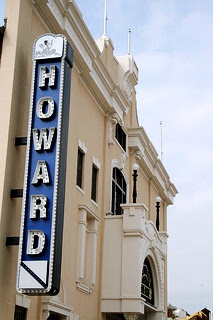>
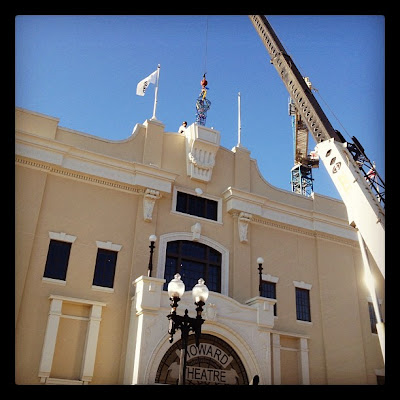
The Washington DC Howard Theatre restoration is a big story being covered by all. With good reason – the historic performing arts venue has new life and the building is topped with a sculpture by Brower Hatcher and Mid-Ocean Studios that included work by DC artist Sean Hennessey (click HERE to jump to WGS posting about the process Sean used to create the trumpet of the ” Jazz Man”.)
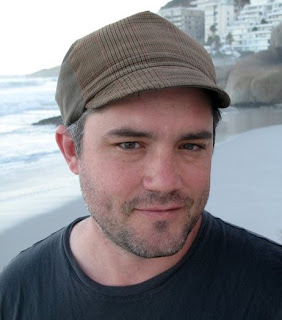
Sean Hennessey – The master caster.
It has been said that any artwork that requires a crane to install is automatically awesome – I agree! 
JRA Penland Trip Update
>
Have a look at the description of the tour:
Hey There…

- Wednesday, August 8 – Arrive at the Inn at Little Switzerland, our base for this trip.
- Thursday, August 9 – Visit the studios of ceramist Michael Sherrill, wood art sculptor Stoney Lamar, metalsmith Hoss Haley and bookmaker Dan Essig, finishing at Blue Spiral Gallery in Ashville.
- Friday, August 10 – Visit the studios of ceramist Christina Cordova and her husband, glass-maker Pablo DeSato; the Penland Gallery, featuring work by artists affiliated with Penland School of Crafts. Our last stop is at Penland for a cocktail party, exhibition preview, silent auction, dinner, live auction, dessert, party, live music and dancing.
- Saturday, August 11 – Start with coffee at The Barns at Penland, shows by both the resident and Core students at Penland, silent auction, lunch, live auction, and a reception at the Penland Gallery. Two major works will be the big spotlight, one by Beth Lipman, and the other by Dan Clayman – both stunning! After the auction, we will head back to the Inn at Little Switzerland for a lovely farewell cocktail and dinner party, where you will be able to swap stories with the new friends you made on this spectacular trip.
- Sunday, August 12 – Time to go home. Transfers are offered to the airport, if needed.

To register for the Penland trip, please fill out the registration form and send it to the James Renwick Alliance by email at admin@jra.org, fax at (301) 907-3855 or mail to the office at 4405 East West Highway, Suite 510, Bethesda, MD 20814.
Vanderbilt University Glass Panels (Part 2)
>


Ardent readers of the Washington Glass School blog will remember earlier posting about theVanderbilt University, where the University’s new Critical Care Tower installed kilnformed glass panels. The project has expanded and additional floors were designed to incorporate more of the kilnformed glass panels in new areas, each with the floating leaf motif. The leaf is the symbol of Vanderbilt University and the oldest part of the Vanderbilt campus is known for its abundance of trees and green space. The campus was designated as a national arboretum in 1988.
The imagery of swirling leaves were always part of the design of the custom glass architectural panels.
Mick Coughlan and Erwin Timmers worked on the creation of the new series of glass panels – some shots of the panels in progress:
Mick Coughlan gives the glass set into the kiln one last clean.
The deep-relief dry plaster kiln casting method is used to create the panels.
Erwin Timmers edge polishes the glass panels. Dousing everything with water.
After the edge polishing Mick & Erwin’s glass edge grinding, impromptu dryers (aka hot kilns) sported wet clothing.
Tim Tate on the Telly!
>This Sunday – April 8, 2012, public television WETA TV (channel 26) will broadcast Vincent Gaines’ documentary on the work and motivations of our superstar Professor Tim Tate – just returned from his successful Fulbright assignment in the UK. The film is “Hearts of Glass” and it is scheduled to air at 2:30 pm on Sunday, and again Wednesday, April 11, 2012 at 5:30 pm. Get those TiVos set!
Happy Easter to Our Peeps
DC’s Historic Howard Theater’s Rebirth
>Public art is part of the restoration of the historic Howard Theater in Washington, DC.



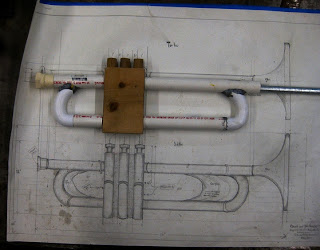

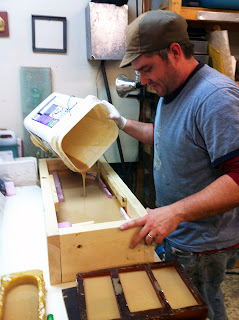


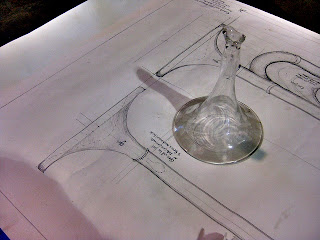

Monday April 9th
11:30-2:30 PM
620 T St NW
Washington, DC
Ooh La La! Susan Taylor Glasgow ‘s “Glamorous Lift” @ GAS Auction
> Susan Taylor Glasgow plans to “support” the Glass Art Society by “lifting” the game of the auction. Her Glass Lingerie Set is part of Laura Donefer’s famed fashion show production that will be part of the the Glass Art Society 2012 Conference (June 13 – 17, 2012 in Toledo, OH).
Susan Taylor Glasgow plans to “support” the Glass Art Society by “lifting” the game of the auction. Her Glass Lingerie Set is part of Laura Donefer’s famed fashion show production that will be part of the the Glass Art Society 2012 Conference (June 13 – 17, 2012 in Toledo, OH).
This conference will specially celebrate the 50th Anniversary of the Studio Glass Movement.
Laura Donefer had put a call for wearable glass creations as part of the auctions that provide the finale for the GAS conference. Susan Taylor Glasgow (the little minx) was once a seamstress, and now takes her needle and thread to glass. The award winning artist often references images of domestic bliss and nostalgic imagery to create sculpture that is strangely comforting and unexpected.
Click here to jump to Susan’s website.
Kiln Formed Glass History – Part 2
>
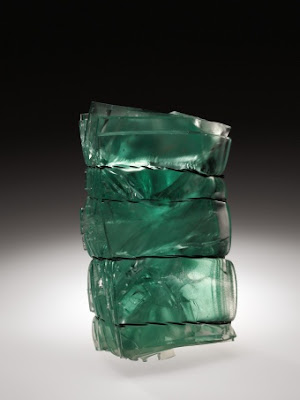
Untitled sculpture, Mary Shaffer, fused and slumped industrial sheet glass, 1975
As part of the 50th Anniversary celebrations in honor of the 1962 Toledo Glass Workshop, the Washington Glass School blog is looking the heritage of the art movement. This is the second part in an historical overview of how fused glass (aka kiln-formed, or warm glass) fits into the contemporary Studio Art Glass Movement. Much of the information was based on published writings by Martha Drexler Lynn, William Warmus & Beth Hylen, Richard LaLonde, Dan Schwoerer & Boyce Lundstrom and from the Corning Museum of Glass library.

Clipped Grass, Mary Ann “Toots” Zynsky, green tinted fused and thermo-formed glass threads, 1982
Antique collecting in the 1960’s brought about a renewed interest in stained glass. Cities such as

The modern stained glass movement, started by mimicking the traditional work evolved into a very diverse art form. Boyce Lundstrom, one of the founders of Bullseye Glass Company wrote:
“Our experience in the glass world pointed to a need for more colored sheet glass for the stained glass industry…(I) began working with glass in 1965, when I joined the new glass program established by Dr. Robert Fritz that year at
In Dr. Fritz’s program I learned to control all phases of the process of making finished blown objects. We built glass melting equipment, calculated and melted batch, formed the glass, and carried out all the cold working processes for finishing the annealed work. After my graduation from
Two of those artists were Ray Ahlgren and Dan Schwoerer, who were partners in a glass blowing. (Ray Ahlgren started his glass career in
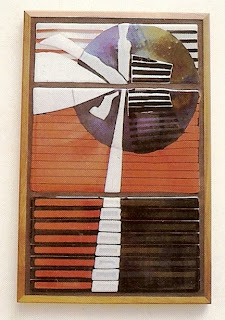
Ray Ahlgren, fused glass tiles, plywood, 1982
Said Boyce: “For the next four years, the pressing demands of an infant company consumed all of my time. In 1978 I began designing independent stained glass panels, executed for me by more capable craftspersons. Since, at Bullseye, we produced mixed colors of glass daily, and had control of the formulas, it seemed a foregone conclusion that we could make sheet glass with similar coefficients of expansion.

Boyce Lundstrom, red glass fused bowl, 1979
The thought process went something like this: if sheet glasses had the same coefficient of expansion, they could be cut into shapes and fused together. So, I started experimenting in 1979 or 1980–I don’t know exactly when because the process was slow at first, fraught with many failures and just a few successes. If there was one memorable breakthrough, it was the application of the method of testing for stress with a polarimeter (from glass blowing) to glasses fused to a clear sheet glass with a constant coefficient of expansion.
When making sheet glass it is not important to have a constant coefficient of expansion among all the glasses. Single colors can all be different and mixed colors only have to be within one or two coefficient points of one another. In glass blowing it is not uncommon to use glasses together that vary in coefficient of expansion by four or five points, because the casing process holds the glass together. But when fusing glass flat, the glasses must be very close in coefficients. Establishing a clear glass as a constant, and then formulating the melt for all colors to fit that constant, made the contemporary glass fusing movement possible.
The ability to fuse glass, by taking it through the complete process of heating, holding and annealing, then checking the finished results with an accurate test, really stimulated my dreams of unlimited possibilities. I saw kiln fired glass as the wave of the future, providing freedom for all those who would like to be freed of the lead lines! Tiles, windows, bowls, sculptures, and building facades could all be made with fused sheet glass… By 1981, I became adamant about producing glass for the fusing market at Bullseye Glass. My remaining partner, Dan Schwoerer, supported me in my one-man campaign to make fusing available to everyone. During the next few years we succeeded in making available a line of fusing compatible glasses. By 1983 we were teaching fusing in diverse parts of the world, establishing a line of products and working with kiln manufacturers to get kilns designed for glass on the market.”
The influence by the hot glass education and artwork by the artists that came from the universities now teaching glass artwork outlined the directions that warm or kiln-formed glass would take. In the late 1960s there was the emphasis on technology and education. The glass artwork was part of broader international craft movement of the 1960s in which clay, fiber, wood, and metal are used for creative expression.
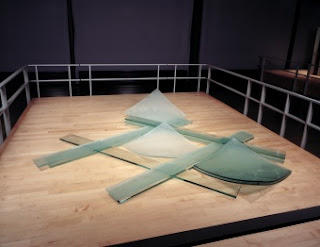
Gyes Arcade, Christopher Wilmarth, flat and curved plate glass elements, 1969
In 1969, glass was rarely seen in contemporary art, especially in large-scale sculpture. However, the American Studio Glass Movement was gathering national momentum. Many studio glass artists looked at contemporary sculpture, such as Gyes Arcade, for inspiration on how glass might be treated artistically.
At the 1972 National Sculpture Conference in Lawrence, Kansas, Harvey Littleton introduces his phrase “Technique is cheap” that continues to influence artists. The dichotomy between the sculptor in search of form (the “technique is cheap” attitude) vs. the craftsman striving to create a perfectly executed functional object is a strong motivation for many artists.
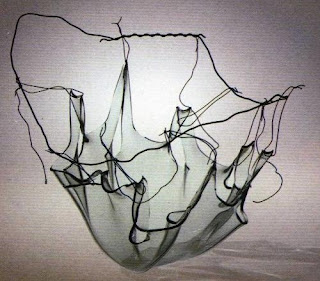
Bowl #2, Mary T Warren, glass, wire, 1978





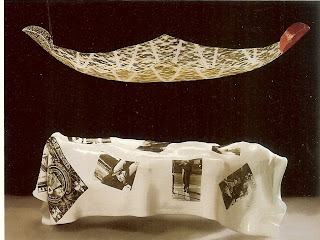
UK Hosts 2nd International Symposium of Architectural Glass
>
The UK International Institute of Research in Glass (IIRG) presents the 2nd International Symposium in Architectural Glass, focusing on ‘Working with light as a means of interaction between space and the mind’.
The emphasis of this event is on how flat glass is used three dimensionally in space and as a creative means of expression. This will explore both the theoretical and practical aspects of this process: idea exploration; design development; use of new technologies; the possibilities of technical restrictions; and the multi-disciplinary approach prevalent in many projects.
The Symposium will run on Thurs/Friday, May 17 &18, 2012 at the National Glass Centre in Sunderland, England. The event will take the form of traditional lectures, panel discussions, workshops demonstrations and informal networking opportunities. Speakers include:
Marian Karel
Dana Zamecnikova
Judith Schaechter
Algirdas Dovydenas
Daan Roosegaarde
Rodney Bender
Tim Macfarlane
Alexander Beleschenko
Early bird fees, if you book and pay before the 1 May:
One day £55, Two days £90
You can book your place through the University online shop, just search Conference/Events International Glass Symposium.
http://onlinestore.sunderland.ac.uk
University of Sunderland, National Glass Centre
Liberty Way
Sunderland, UK, SR6 0GL


